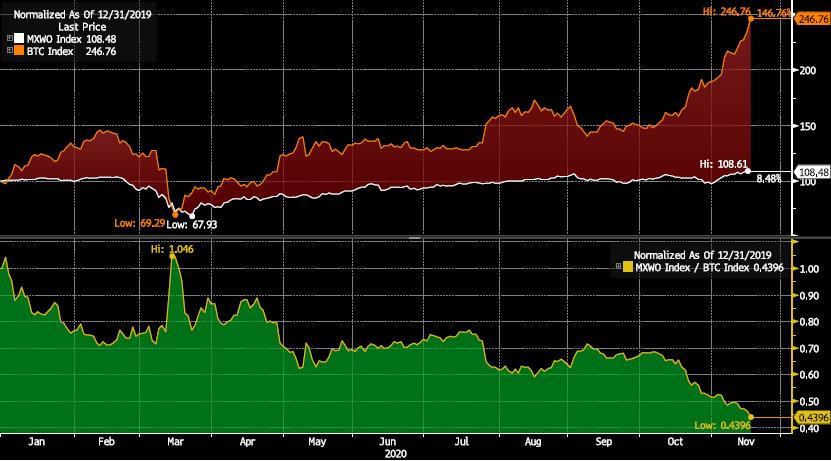
Kevin Gray
Chief Investment Officer
![]() 5 min read
5 min read
E = mc2
E = mc2
‘When a man sits with a pretty girl for an hour, it seems like a minute. But let him
sit on a hot stove for a minute – and it’s longer than any hour. That’s relativity.’
– Albert Einstein
‘What the caterpillar calls the end, the rest of the world calls a butterfly.’
– Lao-Tzu
‘In heaven, an angel is no one in particular.’
– George Bernard Shaw

The meteoric rise of risk assets at a time when fundamentals have seldom looked more dire over the short term has caused yet another existential crisis amongst those finance professionals, and there are still a few, that rely on ‘old fashioned’ fundamental analysis to formulate their view of the world. They would question whether, even with what is highly positive yet fairly early stage vaccine news, the underlying economic fundamentals justify a rise in global equities that at the time of writing leaves them 7% above their previous all time high.
What is going on?
The chemist Antoine Lavoisier in 1789 discovered that in any chemical reaction mass is neither created nor destroyed; atoms themselves just move through chemical compounds in cycles. This same logic can be applied to the financial world. If one assumes that the mass of assets in total remains fairly constant (in the absence of productivity growth), and perceived value flows seamlessly between the different assets that make up that total mass, then the fact that value is looked at through the prism of fiat currency – ‘how many dollars does it cost me to buy asset X?’ – means that as the amount of dollars in the system is increased, those assets will cost more dollars to balance the equation; asset prices goes up.
This is the basis of monetary theory; inflation is seen in terms of how much the growth in the money supply exceeds the growth in the real level of GDP, in other words whether more money is being created to chase a fairly fixed, or at least slow and linearly growing, amount of things.
Money supply matters

Source: Bloomberg
Just how great the increase in US money supply has been post-GFC is illustrated above. The accompanying decrease in money velocity (how often those dollars are circulating around the system) goes a long way to explaining why CPI has not risen; the money is stuck on Wall St and has not found its way to Main St. However, in order to balance the equation, dollar inflation must be expressing itself somewhere.
And it is; on Wall St, in asset prices:

Source: Bloomberg
Rather than thinking in terms of ‘how many dollars does it cost me to buy asset X?’, but instead ‘how many dollars can I buy with asset X?’, it becomes far more reasonable, when considering the incredible central bank action to make dollars less scarce, that equity has risen to the levels it has. But the crucial thing to appreciate is that this is specifically relative to dollars.
Looking at the 2020 return of the MSCI World in terms of a currency which has finite supply, gold, paints a different picture of how the market has fared this year:

Source: Bloomberg
Priced in gold, the MSCI World is down over 10% YTD, and back to the same level it was in the mid 1990s. The narrative around stockmarkets being at all time highs completely depends on what they are being measured against, it is all relative.
Looking at a newer perceived finite store of value in Bitcoin (21 million can be mined in total), the MSCI has plummeted:

Source: Bloomberg
The fact that the global stockmarket index is at a record high against the dollar therefore says as much about the dollar as it does about the perceived prospects of the underlying companies. And the dramatic increase in the likes of gold and digital currency that have been seen this year are undoubtedly in part an expression of investors’ views on fiat currency as an attractive store of value moving forward. Tell a citizen of Venezuela, Russia, Brazil etc that gold is an ineffective inflation hedge. The dollar has simply not been there in terms of debasement, yet.
What now?
The pandemic, and the fiscal and monetary reaction to it, could well mean that the Rubicon has now been crossed. Further money printing, coordinated with increased fiscal spending, is set to characterise the next period of policy. Increased money supply means that a continuation of asset price inflation is likely. Add to this increased fiscal spend funnelling money into the real economy, alongside what Fed Vice Chair Richard Clarida calls ‘an enormous quantity of pent-up saving’, means that reopening is likely to bring about a rise in consumer spending, with the end result being the long awaited rise in CPI too. Fiat currency is likely to continue on its downward trajectory, that is the aim after all. Despite the moniker of ‘long-only’, most multi asset portfolios are in fact, for the most part, long various
asset classes and short fiat currency; one sells their dollars / pounds / euros to buy assets.
Therefore, holding the right types of equity, equity-linked investments, commodities, gold and alternatives may be no bad thing. ‘How many dollars will I be able to buy with the above assets?’ Likely more than now, the equation needs to be balanced. But, the ride will be a lot bumpier for some assets than others.
It is the bond market that should be giving real cause for concern, as here the investor is effectively long fiat currency. Real yields have never been lower and negative yielding debt has reached a record $17trn. ‘How many dollars will bond X buy me at maturity?’ the same number as when it was bought (credit risk aside) and, with yields and credit spreads being at record lows, the income on offer is minimal and the ride could get bumpy. What is more, those dollars at maturity could be worth a lot less than they are today.
It is all relative.
– This document has been issued and approved as a financial promotion by Fortem Capital Limited for the purpose of section 21 of the Financial Services and Markets Acts 2000. Fortem Capital Limited registration number 10042702 is authorised and regulated by the Financial Conduct Authority under firm reference number 755370.
– This document is intended for Professional Investors, Institutional Clients and Advisors and should not be communicated to any other person.
– The information has been prepared solely for information purposes only and is not an offer or solicitation of an offer to buy or sell the product.
– Data is sourced from Fortem Capital Limited and external sources. The data is as at the date of this document and has been reviewed by Fortem Capital Limited.
– Information, including prices, analytical data and opinions contained within this document are believed to be correct, accurate and derived from reliable sources as at the date of the document. However, no representation or warranty, expressed or implied is made as to the correctness, accuracy or validity of such information.
– Fortem Capital Limited assumes no responsibility or
liability for any errors, omissions or inaccuracy with respect to the information contained within this document.
– All price and analytical data included in this document is intended for indicative purposes only and is as at the date of the document.
– The information within this document does not take into account the specific investment objective or financial situation of any person. Investors should refer to the final documentation and any prospectus to ascertain all of the risks and terms associated with these securities and seek independent advice, where necessary, before making any decision to buy or sell.
– The product may not be offered, sold, transferred or delivered directly or indirectly in the United States to, or for the account or benefit of, any U.S. Person.
– The Fortem Capital Progressive Growth Fund is a Sub-Fund of Skyline, an open-ended investment company with variable capital incorporated on 1 June 2010 with limited liability under the laws of Ireland with segregated liability between Funds. The Company is authorised in Ireland by the Central Bank of Ireland pursuant to the UCITS Regulations.
“NOTICE TO INVESTORS DOMICILED OR RESIDENT IN
SWITZERLAND – The interests in the UCITS Fund and any related services, information and opinions described or referenced in this document are not, and may not be, offered or marketed to or directed at persons in Switzerland (a) that do not meet the definition of “qualified investor" pursuant to the Swiss Federal Act on Collective Investment Schemes of 23 June 2006 (“CISA") (“Non-Qualified Investors"), or (b) that are high net worth individuals (including private investment structures established for such high-net worth individuals if they do not have professional treasury operations) that have opted out of customer protection under the Swiss Federal Financial Services Act of 15 June 2018 (“FinSA") and that have elected to be treated as “professional clients" and “qualified investors" under the FinSA and the CISA, respectively (“Elective Qualified Investors").
In particular, none of the information provided in this document should be construed as an offer in Switzerland for the purchase or sale of the interests or any related services, nor as advertising in Switzerland for the interests or any related services, to or directed at Non-Qualified Investors or
Elective Qualified Investors. Circulating or otherwise providing access to this document or offering, advertising or selling the interests or any related services to Non-Qualified Investors or Elective Qualified Investors may trigger, in particular, approval requirements and other regulatory requirements in Switzerland.
This document does not constitute a prospectus pursuant to Articles 35 et seqq. FinSA and may not fulfill the information standards established thereunder. No key information document pursuant to Swiss law has been established for the interests. The interests will not be listed or admitted to trading on a Swiss trading venue and, consequently, the information presented in this document may not fulfill the information standards set out in the relevant trading venue rules."
For more information on the investment philosophy or any of Fortem’s investment offerings, please do not hesitate to contact the team, we would be delighted to hear from you

 ABOUT
ABOUT